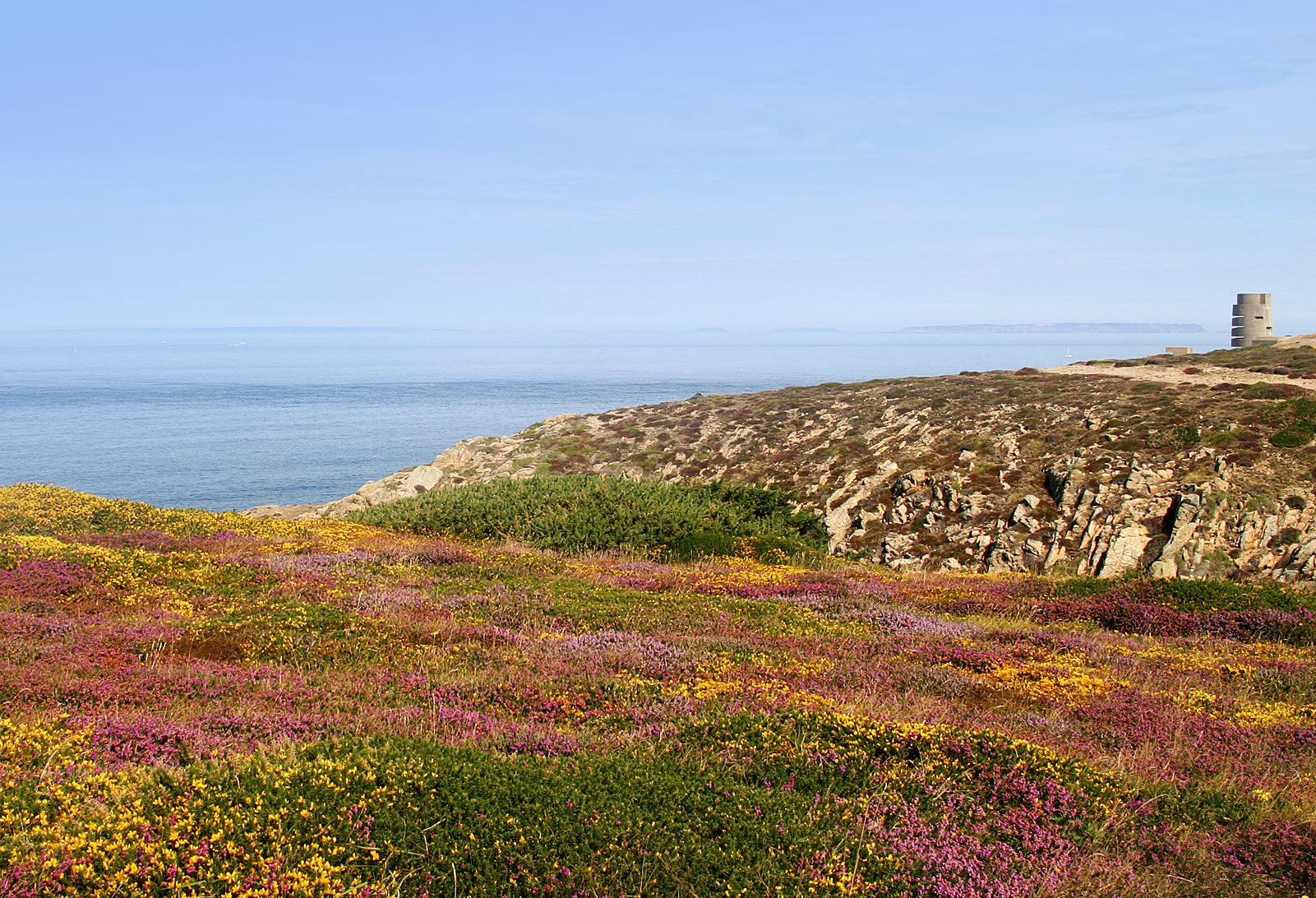
A pair of choughs have been foraging at this site in Corbière (can you spot them?) Photo by Liz Corry.
By Liz Corry
The choughs continued their travels around the Island this October with reports from Corbière, Noirmont and Wolf’s Lair.

Corbière lighthouse. Photo by Liz Corry.

Bo and Mary returned to Corbière this month. Photo by Liz Corry.
There have been several reports from La Pulente, the south end of St Ouen’s Bay. However, this may be a case of misidentification. This end of the bay often attracts large numbers of crows due to the rich pickings available at low tide. In amongst those are another corvid relative, the jackdaw. See our guide to corvid identification here

As the tide goes out at La Pulente the birds come in to feed. Photo by Liz Corry.
Jackdaws have a distinctly different call to crows. They are not as prolific in Jersey as they are in the UK. Understandably, if you are not used to hearing the calls of jackdaws and choughs together you could easily misidentify the two species. Of course there is one obvious way of telling the difference; one has a red bill, the other doesn’t. Not easy to spot when driving – most of the reports came from birders in cars.

Jackdaw calls are often misidentified as chough calls by Jersey residents. Photo by Liz Corry.
The difficult thing with all this is that birds can travel around the coast of Jersey much faster than humans. The birders out recording autumn migration numbers will attest to that. It is quite feasible that choughs were at Pulente, but nipped round the corner to Corbière before I had chance to follow-up the report.

View of La Pulente at the south end of St Ouen’s Bay (bottom left) and Corbière on the southwest corner of Jersey. Image from Google Earth.
End of British Summer Time…and the choughs’ travel plans?
When the clocks changed at the end of October so too did the attendance record at the aviary. We are now seeing more choughs at the supplemental feed. Forty-one being the highest on the eve of the clocks going back. That included Earl and Xaviour who have been living out at Plémont all year.
The increase in numbers is likely due to the cold snap and the reduction in wild food resources. Leatherjackets, a chough favourite, emerged as cranefly and spread their own wings removing themselves from the menu. The choughs reliance on the free food at the aviary will likely increase as we go into winter.

A leatherjacket casing in a coastal garden. Photo by Liz Corry.
The choughs appear to be spending more time foraging around Devil’s Hole and Mourier Valley. At least when the whistle blows for food at 3pm, the majority of the choughs fly in from that direction. They could be fooling us. Probably all are at La Pulente until 2.50pm!
Replacing lost rings
The return of certain choughs to the supplemental feed has made it easier to see who has lost which rings. A catch-up of birds on 28th October attempted to correct this. It took a while to trap the birds in the aviary; the hatches had seized up again despite a check the day before.
It was also a lot harder now there are so many. We managed to lock in about two-thirds of the group and went about the process of hand-netting individuals to check rings.

Bird Keeper Bea Detnon and a very compliant Mauve waiting in line for new leg rings. Photo by Hannah Clarke.
There are several birds we knew needed rings such as Green who had lost all but his original metal ring. Then there were others like Mauve who, on closer inspection, had broken rings creating sharp, hazardous, edges.
All the birds we caught in the nets were weighed and checked over prior to release. There were twelve who got locked in the aviary that we didn’t need.
In amongst this last group was Xaviour who has been missing her orange rings since the start of summer. Unfortunately, she evaded capture. Clearly living out at Plémont has improved her flying skills in close quarters. Since we had already spent an hour catching and processing everyone we called it a day to avoid excessive stress on the group.
Five others still require ring replacements. Weather permitting; we can do that in November.
Feeding stations

A new design of feeder to ensure the choughs get food and nothing else does. Photo by Liz Corry.
Work on the new and improved magpie-proof feeders continues. A quick trip home to see family turned into a research and development trip for the choughs. B&M Bargains, Hobbycraft, Aldi, Lidl….ah the joys of mainland shopping…all threw up some new ideas.
The latest and most successful is a rather unusual choice – flower urns. With slight modification to the container depth, they make the perfect magpie-proof feeder. At the cost of £5.99 for two, salvaged wood and paint (hence the colour choice), they are relatively cheap and easy to make.
To end on a non-bird related note…
At the start of October, the waters around Sorel were graced with the presence of bottle-nosed dolphins. Clearly visible from the cliffpath, the small pod followed alongside a Jersey Seafaris rib as passengers toured the north coast. I tried to capture an image of both choughs and dolphins, but, let’s face it, with my long lens focused on the dolphins; the choughs never stood a chance.

Jersey Seafaris tour joined by bottle-nosed dolphins at Sorel Point. Photo by Liz Corry.


 The other obvious feature for regular readers of this or any other bird list is the changes to the order, relationships and even the birds’ scientific names. Many of us grew up with long held understanding of the order we put the birds in (start with divers and end with crows) and how they were related (divers and grebes, herons and storks). However, new technologies have made it much easier to look closely at every species and get a much better idea of who’s who and where they sit in the order. Wildfowl are first, and not just because they’re very cool but because they and the gamebirds are not that closely related to every other bird. And hawks and falcons aren’t related? No, and strangely that split should have been obvious before.
The other obvious feature for regular readers of this or any other bird list is the changes to the order, relationships and even the birds’ scientific names. Many of us grew up with long held understanding of the order we put the birds in (start with divers and end with crows) and how they were related (divers and grebes, herons and storks). However, new technologies have made it much easier to look closely at every species and get a much better idea of who’s who and where they sit in the order. Wildfowl are first, and not just because they’re very cool but because they and the gamebirds are not that closely related to every other bird. And hawks and falcons aren’t related? No, and strangely that split should have been obvious before. The list actually includes one, or two, other new species. That goose formerly known as the bean goose has become two species: taiga bean goose and tundra bean goose. Luckily for the list compilers, the Islands’ ornithologists had in recent years recorded which of the two bean geese, then considered the lower rank of subspecies, were being seen. The split, and upgrade to full species status, wasn’t hard to fit in. If everything was always so easy. Our other new bird was a Caspian gull. This eastern version of the herring gull was once considered just herring gull until analysis found that it was quite distinct. Only unlike the geese it doesn’t always look distinct and takes a real enthusiast to pick one out of the flock. Luckily this one’s finder and photographer not only knows his gulls but got a little assist in that it was ringed!
The list actually includes one, or two, other new species. That goose formerly known as the bean goose has become two species: taiga bean goose and tundra bean goose. Luckily for the list compilers, the Islands’ ornithologists had in recent years recorded which of the two bean geese, then considered the lower rank of subspecies, were being seen. The split, and upgrade to full species status, wasn’t hard to fit in. If everything was always so easy. Our other new bird was a Caspian gull. This eastern version of the herring gull was once considered just herring gull until analysis found that it was quite distinct. Only unlike the geese it doesn’t always look distinct and takes a real enthusiast to pick one out of the flock. Luckily this one’s finder and photographer not only knows his gulls but got a little assist in that it was ringed!














 From
From 


 From
From 
 Go wild
Go wild Netting, garden string and other litter can all be hazards for hedgehogs.
Netting, garden string and other litter can all be hazards for hedgehogs.
 From
From 
 From
From 


 Having got to where we are, many have asked; How has this all come about ? Well, in the autumn of 2015 The
Having got to where we are, many have asked; How has this all come about ? Well, in the autumn of 2015 The  weekend first island visit in November 2015, was a major factor in Cathy and I deciding to move to Alderney from Kent in March 2016. These early discussions brought about a 2-year observatory establishing pilot project supported by the Wildlife Trust, its primary remit to try and achieve bird observatory accreditation status from the Bird Observatories Council. Local interest and support for this project from the outset was exceptional and largely through Paul’s contacts we soon had a very experienced and capable bird observatory committee driving things forward.
weekend first island visit in November 2015, was a major factor in Cathy and I deciding to move to Alderney from Kent in March 2016. These early discussions brought about a 2-year observatory establishing pilot project supported by the Wildlife Trust, its primary remit to try and achieve bird observatory accreditation status from the Bird Observatories Council. Local interest and support for this project from the outset was exceptional and largely through Paul’s contacts we soon had a very experienced and capable bird observatory committee driving things forward.




 From
From 

 From
From 



